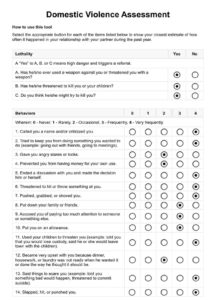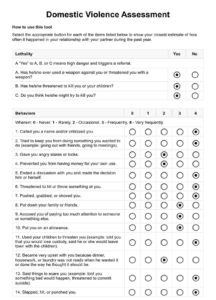When we talk about addressing an issue as pervasive and damaging as domestic violence, reliable data is absolutely critical. It’s not just about counting numbers; it’s about understanding the nuances, identifying patterns, and ultimately, building more effective support systems and prevention strategies. Crafting the right tool to gather this information is paramount, which is why developing an effective and sensitive survey template is so essential.
A well-designed survey can provide invaluable insights into the experiences of survivors, the prevalence of different forms of abuse, the barriers people face in seeking help, and the impact of violence on individuals and communities. Our goal here is to explore what makes an ideal survey template of domestic violence, ensuring it is comprehensive, respectful, and yields actionable information.
Crafting a Sensitive and Effective Survey
Developing a survey on such a sensitive topic requires immense thought and care. The primary concern must always be the safety and well-being of the respondent. A trauma-informed approach is non-negotiable, meaning the survey design should actively work to prevent re-traumatization and ensure the process feels safe and empowering, not intrusive or distressing. This involves careful phrasing, clear consent procedures, and a clear understanding of the potential emotional impact of the questions asked.
Beyond safety, the effectiveness of the survey hinges on its ability to gather accurate and comprehensive data. This involves a mix of question types, from straightforward demographic inquiries to more nuanced questions about the nature, frequency, and severity of abusive behaviors. We need to consider both quantitative data (how often, how many) and qualitative insights (how did it feel, what was the impact).
Key Elements of a Trauma-Informed Approach
- **Safety:** Ensuring physical and psychological safety for respondents, including clear disclaimers and options to skip questions or stop the survey at any time.
- **Trustworthiness and Transparency:** Being clear about why the data is being collected, how it will be used, and who will have access to it.
- **Peer Support:** While not always directly integrated into a survey, the design should acknowledge the importance of peer connections and support networks.
- **Collaboration and Mutuality:** Involving survivors and experts in the design process to ensure the survey is relevant and respectful.
- **Empowerment, Voice, and Choice:** Giving respondents control over their participation, including the ability to provide feedback and decide what information they share.
- **Cultural, Historical, and Gender Issues:** Recognizing and responding to diverse backgrounds and experiences, avoiding assumptions based on cultural norms or gender roles.
The language used throughout the survey must be clear, simple, and free of jargon. Ambiguous terms can lead to misinterpretation and inaccurate data. It’s crucial to define what "domestic violence" or specific types of abuse (e.g., emotional abuse, financial abuse) mean within the context of the survey, without being overly clinical. Questions should be direct but empathetic, avoiding leading questions or those that might imply blame. Finally, consider how the survey will be administered – online platforms can offer anonymity and reach a wider audience, while in-person or phone interviews might be more suitable for reaching individuals without internet access or for those who prefer personal interaction, provided safety protocols are strictly followed.
Essential Sections for Your Survey Template
An ideal survey template of domestic violence typically begins with an introduction that sets the stage and secures informed consent. This section should clearly state the purpose of the survey, emphasize confidentiality and anonymity, explain how the data will be used, and provide information on support resources. It’s vital to inform participants that they can stop at any time and that their participation is voluntary. This upfront transparency builds trust and helps ensure ethical data collection.
Following consent, demographic questions are usually included. While sensitive, these are crucial for understanding the profile of respondents and identifying potential disparities or specific needs within different communities. This might include age, gender identity, sexual orientation, race/ethnicity, education level, employment status, and relationship status. Questions about the abuser’s relationship to the respondent (e.g., spouse, partner, ex-partner, family member) are also important here to categorize the type of domestic violence experienced.
The core of the survey will delve into the experiences of violence. This section should cover various forms of abuse: physical, emotional/psychological, sexual, financial, and digital. Instead of just asking "Have you experienced abuse?", it’s more effective to use specific, behavioral-based questions. For example, "Has a partner ever prevented you from seeing friends or family?" or "Has a partner ever controlled your access to money?". Questions should also cover the frequency and duration of the abuse.
Beyond the nature of the abuse, an effective template will explore its impact. This includes questions about the effects on physical health, mental health (e.g., anxiety, depression, PTSD symptoms), employment, housing, and the well-being of children if applicable. Understanding the consequences helps highlight the broad societal cost of domestic violence and the multifaceted support services required.
Further sections should focus on help-seeking behaviors and barriers. Did the individual seek help? From whom (e.g., friends, family, police, shelters, therapists)? What were the outcomes? Equally important are questions about why help was not sought, which can uncover critical systemic barriers such as fear, lack of resources, language barriers, or distrust in institutions. Finally, including a section for open-ended comments allows respondents to share experiences or insights that might not have been captured by closed-ended questions, providing rich qualitative data.
The insights gained from such a thoughtfully constructed survey are invaluable for advocates, policymakers, and service providers. They can pinpoint gaps in existing services, inform the development of targeted interventions, and highlight the true scope of domestic violence. This collective understanding empowers us to create a society where everyone can live free from fear and abuse, supported by robust and empathetic systems of care.



